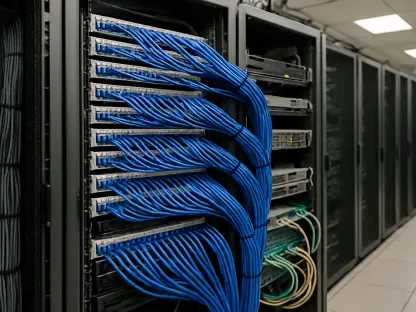A few years ago, network infrastructure was largely invisible, reliable, functional, and out of sight. But in today’s digital-first world, that passive role no longer cuts it. With hybrid work, cloud-native apps, and AI-driven operations now the norm, the network has become a critical business enabler. In fact, your network could be the difference between your company lagging behind or leading the market.
This article explores how and why networking has become a cornerstone of the modern business strategy, and what organizations like yours must do to keep up.
The Strategy Behind the Switch
Traditionally, network infrastructure was engineered for stability and scale; its job was to support traffic flow, secure data, and “stay out of the way.” But that didn’t hold for long because today, businesses are increasingly competing on how quickly and intelligently they can adapt, and agility is only possible if the network supports it.
A recent Gartner report estimates that by 2026, 75% of enterprise-generated data will be created and processed outside traditional data centers or cloud environments. That shift is being driven by rising costs, performance concerns, and the need for real-time access. From edge computing to AI workloads, the demands placed on network architecture have changed, and forward-looking businesses are responding by making infrastructure part of strategic planning.
In this new paradigm, IT and business leaders are collaborating more closely, leveraging the network to launch digital services, manage M&A transitions, and enable faster decision-making.
Looking at the Rise of Cloud-First Networking
The shift toward digital tools has triggered a similar shift in infrastructure strategy. Instead of routing everything through a central hub, enterprises are embracing cloud-first networking models to bring users closer to their applications. Software-defined wide-area networking is instrumental here. With centralized management and intelligent traffic steering, this system offers the flexibility needed in a remote and distributed world.
But security matters, too, in this environment, and that’s where Secure Access Service Edge comes in. By unifying networking and security within one cloud-native framework, it offers elastic security without compromising user experience. As Brian Ramsey (VP Sales, Xalient) says in an Intelligent CIO article, “Secure Access Service Edge is not just a passing trend but a strategic imperative.”
Redefining Operational Efficiency With Network Automation
Cloud-native, digitally distributed networks cannot be managed manually. As environments grow more dynamic, businesses are turning to automation to manage complexity and increase resilience. Technologies like zero-touch provisioning, intent-based networking, and AIOps software can monitor, configure, and even repair networks autonomously in real time. The return? Faster problem-solving, reduced downtime, and more time for IT personnel to focus on innovation, not routine troubleshooting.
But these tools do more than reduce manual effort. They’re making the network itself smarter.
AI-powered automation solutions are learning from network behavior over time. By analyzing usage patterns, predicting congestion, and identifying anomalies before they escalate, the network becomes an intelligent system in its own right. This shifts the role of IT from reactive to proactive: Instead of chasing issues, they’re anticipating needs and optimizing performance in real time.
Enabling Hybrid and Distributed Work
Nowadays, work has become more of a platform than a place, and employees expect instant, secure access to tools and knowledge from anywhere. That puts a strain on IT to deliver performance, dependability, and security across devices, geographies, and time zones.
Networking is in the middle of it all. From endpoint compliance to video call quality optimization, network teams are essential to employee experience.
Technologies like Wi-Fi 6 and private 5G are also on the rise, offering high-speed, low-latency connectivity in-office and off-site, so firms that invest in upgrading their infrastructure today will be better placed to attract and retain employees tomorrow.
Data-Driven Networking
Your network sees all, and with the right tools, that visibility can be translated into real business value. Whether detecting performance issues or security threats, network data is becoming a strategic asset.
Advanced telemetry and analytics provide demand forecasting, operational simplification, and problem detection before problems snowball. Cisco, Arista, and Extreme Networks are among the firms doubling down on AI-powered monitoring, helping organizations gain insights that go far beyond the IT department. These platforms detect anomalies in user behavior, identify application bottlenecks, and even flag potential compliance risks. This gives business leaders visibility into how digital tools are actually being used, where processes break down, and where customer or employee experiences might be suffering.
As network complexity increases, so does the value of clear, real-time insight. Using network infrastructure intelligence to make strategic decisions grounded in live operational data will get you there.
Security: Built Into the Foundation
The more critical your network becomes, the more it needs to be protected. Modern threats look for vulnerabilities deep within the infrastructure.
That’s why security can not be an afterthought. From Zero Trust Architecture to continuous authentication and segmentation, organizations are embedding protection at every layer. IBM, in their 2024 Cost of a Data Breach Report, stated that companies with mature zero trust strategies save an average of $1.76 million per breach.
So, when security is part of your network’s DNA, resilience becomes a built-in feature, not a reactive fix.
Looking Ahead: The Network as a Business Platform
Looking forward, networking is poised to surpass its role as a support system and become a business platform. As AI, edge computing, and real-time applications become the norm, networks will play an even bigger role in shaping business success. It will power everything from smart factories to real-time customer engagement.
Enterprises that invest in future-ready networking now will be positioned to lead in a world where responsiveness, intelligence, and digital experience define competitive edge. From enabling real-time supply chain decisions to personalizing customer interactions at the edge, the network will shape how business is done.
To achieve this, companies must reframe their approach to infrastructure.
Conclusion
Rethinking networking as a strategic advantage
Networking has outgrown its reputation as “just IT’s problem.” As seen, it is now a vital part of any business strategy, from enabling real-time responsiveness at the edge to supporting hybrid workforces with cloud-first and AI-driven infrastructure.
Today’s networks are automated for scale, secured by design, and rich with data that offers visibility far beyond technical performance. Whether it’s leveraging AI to preempt outages, embedding zero trust frameworks to reduce breach impact, or using analytics to optimize digital experiences, the network has become central to how modern enterprises operate, compete, and grow.
Those who continue to treat it as a background tool will fall behind. But those who bring it into their daily operations will be ready for whatever comes next. Because in today’s world, the strongest businesses lead with powerful networks.









